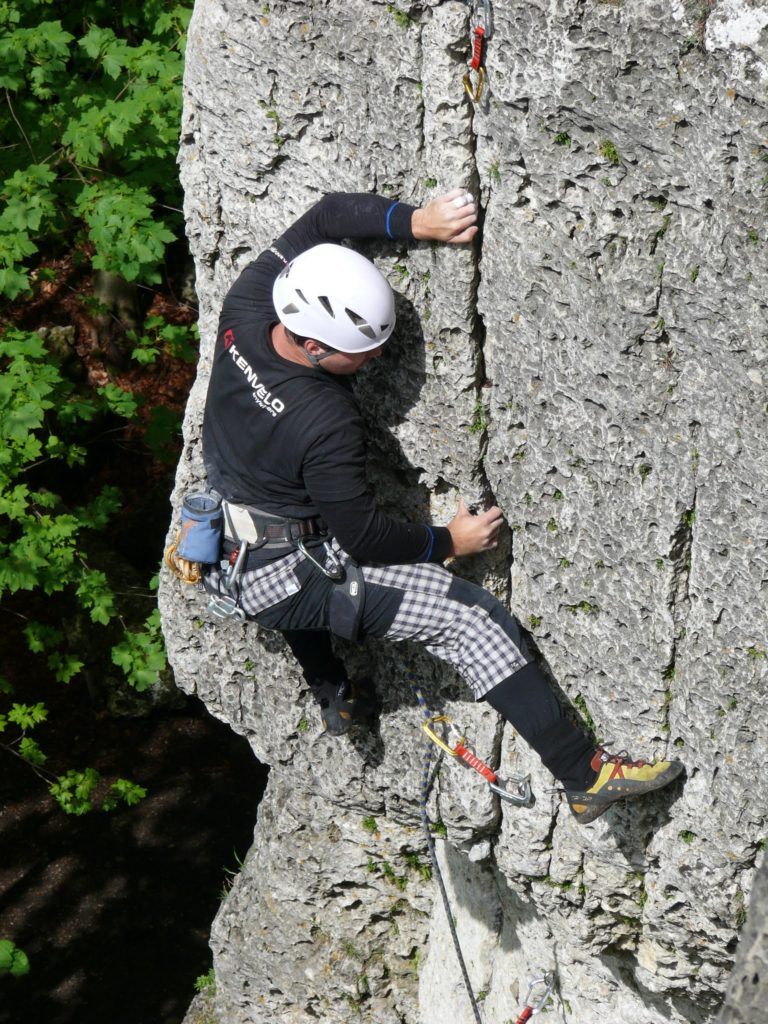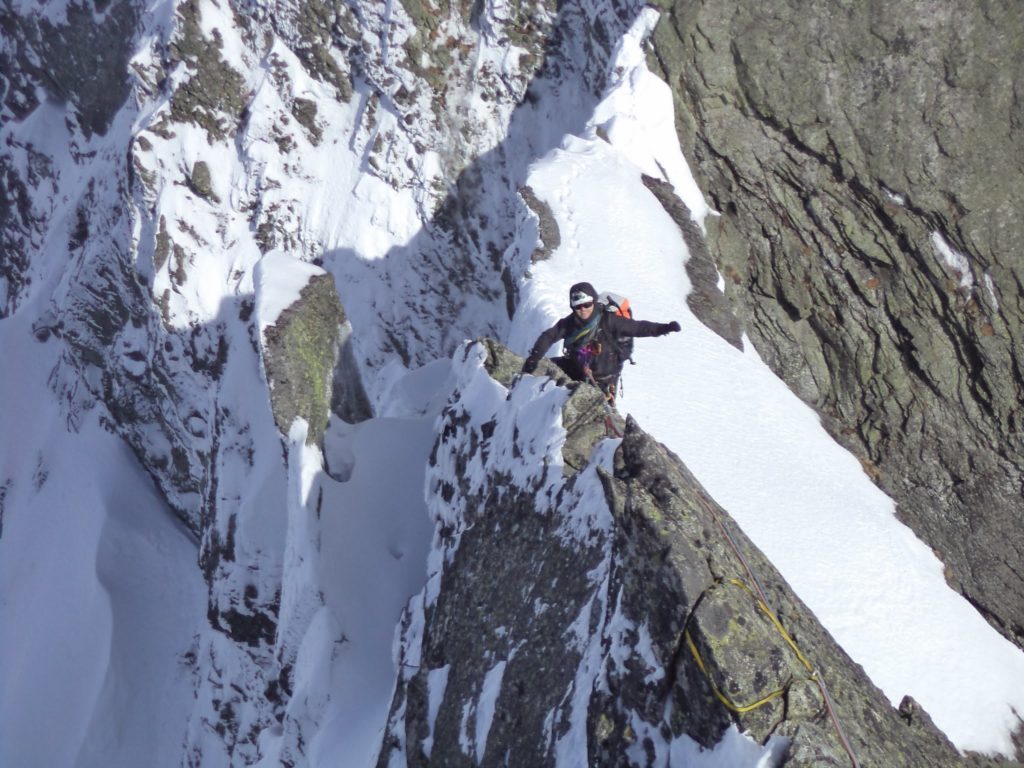He has been programming for more than 20 years, and this year he will celebrate his 15th anniversary at Profinit, where he specializes in C# and .NET development. However, Miro Piroh is a pro at more than just writing code. For years, he has also had a passion for climbing, so we decided to ask him something about that. In the interview, you’ll find out what he likes best about climbing, what his most difficult climb was, what his favourite place is, and even, if it is hard to combine climbing with working at Profinit.
How did you get into climbing and what do you like best about it?
I got into climbing mostly by accident and quite late. It happened when I was in Prague, which was after university. At the time, I was doing a lot of sport, and I was thinking about trying something new. I heard about a climbing course and decided to give it a shot.
And what do I like best about climbing? That’s a difficult question. Regarding the climbing itself, it’s the creativity of the movement. Often, you need to figure out how to climb over a harder spot, and it’s nice that everyone can figure it out for themselves. So, climbing isn’t just a physical sport. You have to think a lot, especially if you want to climb harder routes. It’s like playing chess. You need to think a few steps ahead, choose a suitable strategy, and judge well where to rest and where it’s better to climb quickly. The great thing about climbing rocks or mountains is that you get to spend time outdoors in nature.
How often do you climb?
Less than I’d like. 🙂 I try to go a couple of times a week to at least keep in shape. Usually, two or three times. It’s not like in the beginning, when I used to climb almost every day. Now, I mostly climb on indoor climbing walls, typically in the evening after work, and then, once in a while, I climb some rocks or take a trip to the mountains for a few days.
Is it difficult to combine climbing and work?
At Profinit, we have relatively flexible working hours and the option to work from home, which makes it much easier to combine work and climbing. When you practice on a climbing wall in the evening after work or in the morning before work, it’s about the same as any other sport. It’s more difficult when you want to climb outdoors on the rocks or in the mountains. It really depends on the weather. Unlike some other sports, climbing doesn’t go very well in the rain. In the summer, it’s worthwhile to finish work early in the afternoon and go to some rocks somewhere nearby. Some people do longer trips, where they combine climbing days and rest/working days. That wouldn’t work at another job.
“At Profinit, we have relatively flexible working hours and the option to work from home, which makes it much easier to combine work and climbing.”
What was your most difficult climb?
When it comes to the level of difficulty, the grades are not so high, but that’s probably because I’ve never really trained properly. I’ve always just climbed for fun, and any improvement was more due to me climbing more often. But it’s true that I try to improve, and I try harder routes. My main motivation has always been to be more at ease when climbing in the mountains. In the mountains, I always climb below what I am capable of because I don’t want to fall. It’s not always safe regarding belay options. So, to be specific, in terms of numbers, it’s currently 9- on the climbing wall and 8+ on the rocks (according to the UIAA scale). However, I have more appreciation for some of the easier climbs I have done in the mountains. There, it’s not only about the physical challenge but also a lot about the psychological challenge. Climbing in the mountains is very different from climbing an artificial climbing wall, where you have quickdraws after a meter and can 100% rely on them, or climbing on the rocks, where you have fixed bolts with quickdraws after three meters and it’s still relatively safe. In the mountains, you don’t have fixed bolts and have to put your own protection. Plus, the distances can be really big and you have to be sure that you have placed the gear correctly. Sometimes there is a real risk of a very long fall, which, due to the ruggedness of the terrain, wouldn’t have a happy ending. It’s like climbing on sandstone. You just don’t fall.
What’s your favourite area / region / mountain range for climbing?
I have several favourites. For rock climbing (small rocks typically up to 30m), I like Frankenjura in Germany. It is a beautiful area of Bavaria where there are lots of rocks hidden in the forests. There are a lot of very well-bolted routes so that everyone can climb there. As far as mountains, at first, my favourite was the Dolomites in Italy. But then, I started climbing more in Slovakia, in the High Tatras. This is very much due to the accessibility from Prague and the fact that I have family there. In recent years, I have gotten used to climbing solo, typically doing easy climbs where the most important thing is not to be afraid.
But if I had more time, there are definitely a lot of other places where I would like to climb. I’m tempted by Patagonia, for example. But that would require a lot of experience with winter climbing, and I don’t have much of that yet. As for Bohemia, I enjoy climbing on the sandstones near Tisá.
“I’ve done some winter climbs, and I hope to eventually try something harder in higher mountains.”
How do you acclimate to high altitudes?
I haven’t really had much experience with that. High mountains haven’t attracted me too much yet, but it is true that they are gradually starting to. I’ve only been to the Alps (around 4000m) once, and that was the very first year I started climbing. But it was more about high-altitude hiking. The highest I’ve climbed was to 3000m, which was fine. From what I can tell, the main problem with climbing at high altitudes is that it requires experience with winter climbing, which I feel like I don’t have enough of. And I’m afraid of avalanches. 🙂 It also has to be said that winter climbing is much more suffering than summer climbing due to the cold conditions. I’ve done some winter climbs, and I hope to eventually try something harder in higher mountains.
What advice would you give beginners who are considering taking up climbing?
I definitely recommend starting with a climbing course. At nearly every climbing gym, there are instructors that teach beginners. I definitely don’t recommend just learning on your own. I often see people on the wall who don’t even know if they have tied the right knot. If you want to start without an instructor, then only do bouldering. But even then, it’s good to know at least the basic techniques.
In any case, I’d recommend climbing to anyone. If you just want to do it for fun, it’s a pretty safe sport where you stretch your whole body and discover muscles you didn’t even know you had. 🙂
When you go to the rocks or the mountains, you will have a lot of interesting experiences, and you will definitely make many new friends while climbing.

